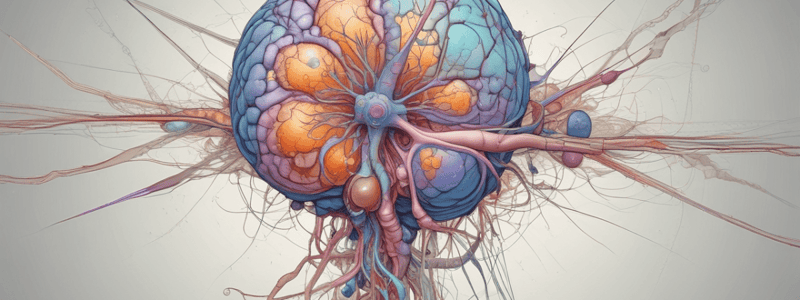Podcast
Questions and Answers
What is the process by which the neural plate is formed from the ectoderm layer?
What is the process by which the neural plate is formed from the ectoderm layer?
- Neurogenesis
- Neural induction (correct)
- Dorsoventral patterning
- Neural tube formation
Which of the following structures forms a furrow in the neural plate?
Which of the following structures forms a furrow in the neural plate?
- Neural groove (correct)
- Neural crest
- Neural plate
- Neural tube
What is the result of the neural tube failing to close properly?
What is the result of the neural tube failing to close properly?
- Neural tube formation
- Neural plate formation
- Neural tube defects (correct)
- Neurogenesis
Which of the following tissues is formed from neural crest cells?
Which of the following tissues is formed from neural crest cells?
What is the process by which neurons are generated from neural stem cells?
What is the process by which neurons are generated from neural stem cells?
What is the caudal part of the neural tube that forms the spinal cord?
What is the caudal part of the neural tube that forms the spinal cord?
What type of neurons transmit signals from sensory receptors to the spinal cord?
What type of neurons transmit signals from sensory receptors to the spinal cord?
Which of the following signaling pathways regulates neural development?
Which of the following signaling pathways regulates neural development?
Flashcards are hidden until you start studying
Study Notes
Early Neural Development
- Neural induction: process by which the neural plate is formed from the ectoderm layer
- Neural plate: a thickened layer of ectodermal cells that will give rise to the nervous system
- Neural groove: a furrow that forms in the neural plate, which will eventually close to form the neural tube
Neural Tube Formation
- Neural tube closure: process by which the neural groove closes to form a tube
- Neural tube defects: abnormalities that occur when the neural tube fails to close properly (e.g. spina bifida, anencephaly)
- Neural crest cells: cells that migrate from the neural tube to form various tissues, including the peripheral nervous system, skin, and bone
Brain Development
- Three primary brain vesicles: the prosencephalon (forebrain), mesencephalon (midbrain), and rhombencephalon (hindbrain)
- Five secondary brain vesicles: the telencephalon (cerebrum), diencephalon (thalamic region), mesencephalon (midbrain), metencephalon (pons and cerebellum), and myelencephalon (medulla oblongata)
- Neurogenesis: process by which neurons are generated from neural stem cells
- Neuronal migration: process by which neurons move to their final positions in the brain
Spinal Cord Development
- Neural tube: the spinal cord forms from the caudal part of the neural tube
- Neuroepithelial cells: cells that give rise to the spinal cord
- Dorsoventral patterning: process by which the spinal cord is patterned along the dorsoventral axis
- Motor neurons: neurons that transmit signals from the spinal cord to muscles and glands
- Sensory neurons: neurons that transmit signals from sensory receptors to the spinal cord
Molecular Mechanisms
- Signaling pathways: molecular pathways that regulate neural development, including the Notch, Wnt, and Shh pathways
- Transcription factors: proteins that regulate gene expression during neural development, including Pax, Sox, and Nkx
- Growth factors: proteins that regulate the growth and survival of neurons, including neurotrophins and fibroblast growth factors
Early Neural Development
- Ectoderm layer gives rise to the neural plate through neural induction
- Neural plate is a thickened layer of ectodermal cells that will form the nervous system
- Neural groove forms in the neural plate, which will eventually close to form the neural tube
Neural Tube Formation
- Neural tube closure occurs when the neural groove closes to form a tube
- Failure of neural tube closure leads to neural tube defects, such as spina bifida and anencephaly
- Neural crest cells migrate from the neural tube to form the peripheral nervous system, skin, and bone
Brain Development
- Three primary brain vesicles: prosencephalon (forebrain), mesencephalon (midbrain), and rhombencephalon (hindbrain)
- Five secondary brain vesicles: telencephalon (cerebrum), diencephalon (thalamic region), mesencephalon (midbrain), metencephalon (pons and cerebellum), and myelencephalon (medulla oblongata)
- Neurogenesis is the process by which neurons are generated from neural stem cells
- Neuronal migration is the process by which neurons move to their final positions in the brain
Spinal Cord Development
- Spinal cord forms from the caudal part of the neural tube
- Neuroepithelial cells give rise to the spinal cord
- Dorsoventral patterning is the process by which the spinal cord is patterned along the dorsoventral axis
- Motor neurons transmit signals from the spinal cord to muscles and glands
- Sensory neurons transmit signals from sensory receptors to the spinal cord
Molecular Mechanisms
- Signaling pathways, including Notch, Wnt, and Shh, regulate neural development
- Transcription factors, such as Pax, Sox, and Nkx, regulate gene expression during neural development
- Growth factors, including neurotrophins and fibroblast growth factors, regulate the growth and survival of neurons
Studying That Suits You
Use AI to generate personalized quizzes and flashcards to suit your learning preferences.





